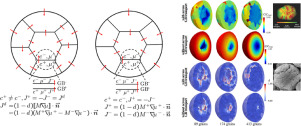当前位置:
X-MOL 学术
›
Scr. Mater.
›
论文详情
Our official English website, www.x-mol.net, welcomes your
feedback! (Note: you will need to create a separate account there.)
A chemo-mechanical grain boundary model and its application to understand the damage of Li-ion battery materials
Scripta Materialia ( IF 5.3 ) Pub Date : 2020-07-01 , DOI: 10.1016/j.scriptamat.2020.03.027 Yang Bai , Kejie Zhao , Yao Liu , Peter Stein , Bai-Xiang Xu
Scripta Materialia ( IF 5.3 ) Pub Date : 2020-07-01 , DOI: 10.1016/j.scriptamat.2020.03.027 Yang Bai , Kejie Zhao , Yao Liu , Peter Stein , Bai-Xiang Xu

|
Abstract Although the unique mechanical and transport features of grain boundaries (GBs) in polycrystalline ion conductors have been recognized, the understanding of the chemo-mechanical interplay and its impact is insufficient. We present a coupled GB model which includes both the damage-dependent across-grain transport and a mechanical cohesive zone law. 3D simulations on LiNixMnyCozO2 demonstrate that the chemical process and the mechanical degradation go hand-in-hand: the enhanced intergranular chemical inhomogeneity challenges the GB mechanical strength, while the GB damage influences or even blocks the across-grain transport. Results explain well the experimentally observed features including chemical hot spots and surface layer delamination.
中文翻译:

化学机械晶界模型及其在理解锂离子电池材料损伤中的应用
摘要 尽管多晶离子导体中晶界 (GBs) 的独特机械和输运特性已得到认可,但对化学-机械相互作用及其影响的理解还不够。我们提出了一个耦合 GB 模型,其中包括与损伤相关的跨晶粒传输和机械内聚区定律。LiNixMnyCozO2 的 3D 模拟表明化学过程和机械降解是齐头并进的:增强的晶间化学不均匀性挑战了 GB 机械强度,而 GB 损伤影响甚至阻止了跨晶粒传输。结果很好地解释了实验观察到的特征,包括化学热点和表层分层。
更新日期:2020-07-01
中文翻译:

化学机械晶界模型及其在理解锂离子电池材料损伤中的应用
摘要 尽管多晶离子导体中晶界 (GBs) 的独特机械和输运特性已得到认可,但对化学-机械相互作用及其影响的理解还不够。我们提出了一个耦合 GB 模型,其中包括与损伤相关的跨晶粒传输和机械内聚区定律。LiNixMnyCozO2 的 3D 模拟表明化学过程和机械降解是齐头并进的:增强的晶间化学不均匀性挑战了 GB 机械强度,而 GB 损伤影响甚至阻止了跨晶粒传输。结果很好地解释了实验观察到的特征,包括化学热点和表层分层。











































 京公网安备 11010802027423号
京公网安备 11010802027423号